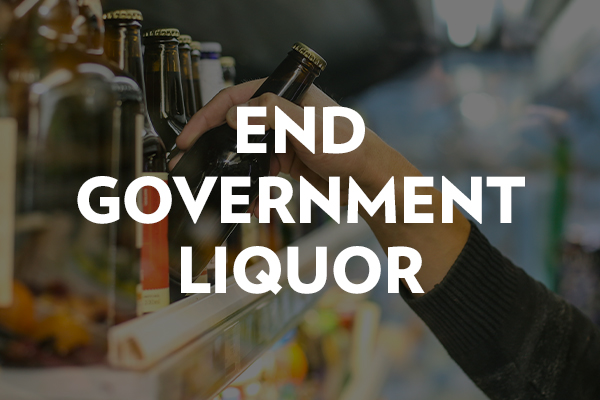Fact Sheet

Economic Aspects of Liquor Privatization
Gold Mine Business, Utility Profit
- The Pennsylvania Liquor Control Board (PLCB) is highly unprofitable—especially considering its statewide monopoly. Of the PLCB’s $2.1 billion in sales for the fiscal year ended June 30, 2019, only 9% remained after expenses for transfer to the commonwealth general fund. The PLCB spends most of its earnings on itself.
- The PLCB transferred $185 million to the General Fund in 2019, that’s less than 1% of General Fund spending.
- Even the present low level of transfers to the state isn’t secure, because the PLCB has a weak debt position. The PLCB has employee retirement liabilities totaling $1.1 billion and a gap between its assets and liabilities that is also about $1.1 billion.
Restricted Supply and Conflicted Incentives
- PLCB has performed abysmally in the present crisis, to say the least. Despite launching a new web portal taking curbside orders at a rate of about 7,000 per day, the PLCB’s prolonged shutdown and its incompetence in selling online have cost it about $47 million in lost revenue. This loss is also a loss of sales tax revenue and a large amount of unfulfilled consumer demand.
- Supply was restricted before the crisis as well. A liquor store density report from 2017 ranks Pennsylvania in line with New Mexico, a desert state, in terms of liquor stores per head. As of 2018-19 the PLCB operated 603 retail facilities, of which 484 were standard stores. If Pennsylvania reflected the average density of control states, the PLCB would operate more than 1,000 outlets.
- The PLCB’s mission makes no sense. In other countries, government liquor monopolies are for alcohol control purposes and the monopoly restricts distribution, but does not seek a profit. The PLCB’s muddled mission of profiting from drinking while nominally discouraging it, by contrast, leads to some strange results like unreasonable advertising restrictions.
- For example, wineries may not advertise volume discounts on the grounds that this constitutes an “inducement to purchase alcohol.”
Border Bleed
- A significant number of Pennsylvanians continue to buy alcohol out-of-state and bring it in (this is illegal but usually unenforced). A border bleed study from 2011 indicated on page 12 that about 40% of consumers mixed in-state and out-of-state alcohol purchases.
- The tax revenue sums involved are meaningful: page 121 of the same study indicates that when consumers do go out of state, they spend three- and even four-figure amounts.
- Since alcohol prices in Pennsylvania have only risen relative to other states the past decade (see below), it is hard to believe these trends have changed.
- Border bleed accelerated when the PLCB shut down, depriving the state of tax revenue and forcing residents into nominally illegal activity. Storekeepers and governors in other states, like Ohio, even barred Pennsylvania purchasers.
- Believe it or not, there’s more freedom for Europeans (including citizens of countries that have liquor monopolies) to carry alcohol between countries, than residents of Pennsylvania are given to legally carry alcohol from Delaware.
PLCB Harms Businesses
- Licenses are limited to 1 per 3,000 residents. In other words, not all the restaurants that would like to serve alcohol are able to do so. For business owners in Pennsylvania limited supply of licenses drives the cost up, and it can be upwards of $500,000.
- As of 2014, only 18 states had quota systems for liquor licensing. Of those states only 7 had lower per capita limits than Pennsylvania.
- Local restaurants are burdened under artificially high prices. As of 2018, the average PLCB markup on spirits was 65 percent with only a 10 percent discount for licensees.
- The PLCB spent taxpayer dollars to create, copyright, and market its in-house brand TableLeaf, which was produced in California. This means local producers’ own tax dollars are funding their competition.
The Broken Promise of Flexible Pricing
- The last round of reforms, Act 39 of 2016, granted some alcohol liberalization in Pennsylvania (limited grocery store sales, for instance) but increased the PLCB’s power to set prices. Partial liberalization did not deliver the value promised.
- Formerly the PLCB sold wine and spirits at a fixed 30% markup that applied to all brands and suppliers. Act 39 gave the PLCB full pricing discretion and made retail prices the result of closed-door deliberation.
- The PLCB led the public to believe it would negotiate good deals for consumers. A new study suggests the opposite is true.
- Consultant S.E. Koontz, working on behalf of the Distilled Spirits Council, the Wine Institute and the Distilled Spirits Alliance, analyzed acquisition costs and PLCB list prices for distilled spirits in the two years before Act 39 implemented flexible pricing (2015 and 2016) and the two years following (2017 and 2018).
- The study found that shelf prices (normalized to per-case amounts for accurate comparison) on spirits rose 7.6%, from $167.03 to $180.61.
- Shelf prices on popular wine brands were up 8.5 percentage points, from 60.8% to 69.3%. Across the nation over the same time span, wine and spirits prices rose less than 1%, according to this study.
- The PLCB isn’t standing between private suppliers and retail buyers for retail buyers benefit rather, it extracts a premium from both.
- The PLCB’s powers under Act 39 are actually extraordinary enough that they risk an international trade dispute. Because the PLCB is government entity, its ability to impose a markup is effectively taxing power, and, in the case of foreign goods, the power to impose discriminatory tariffs.